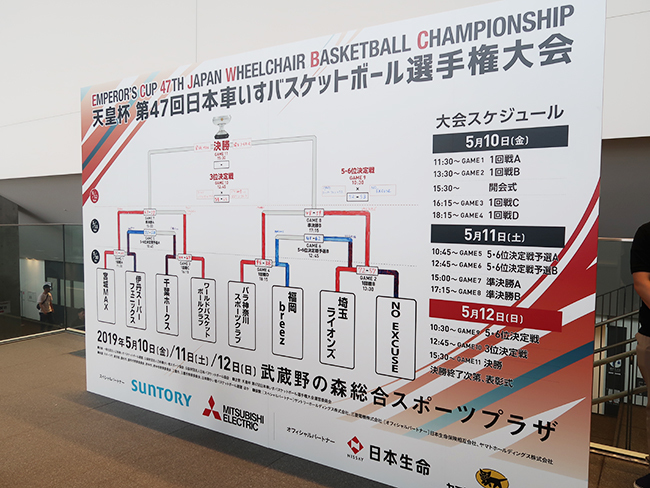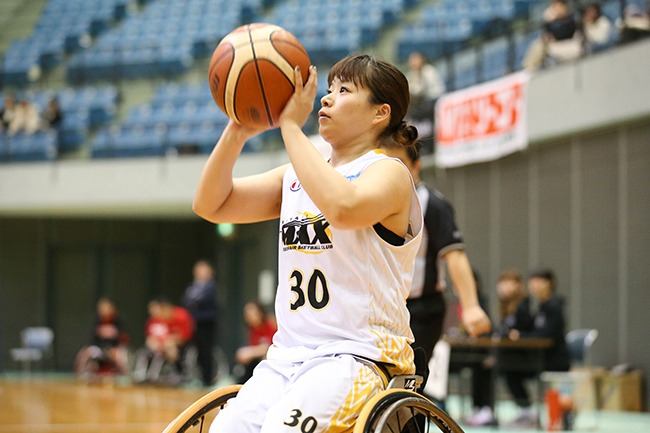How to invite someone to wheelchair basketball.
Two months prior.
Having extended this year's Golden Week beyond its usual peak period by adding two extra days off, I found myself completely out of sync with reality when that day arrived. On a Sunday afternoon, gazing blankly out the taxi window in the gentle sunlight, a barrage of rapid-fire chatter hit me harder than the rays themselves.
"Wheelchair basketball is happening there today! The Emperor's Cup!
The preliminaries started a few days ago, right? Yesterday, I actually picked up one of the players.
The intensity is incredible. Wheelchairs colliding with each other."
The driver seemed quite knowledgeable.
"Driver, have you ever watched a game?"
"No, I haven't."
You haven't?!
"It looks fun, so I'm interested though."
That feeling really resonated with me.
I came because I got this chance this time,
but even if you're interested, there's a bit of a hurdle to actually going.
How can we overcome that surprisingly high barrier?
What would make that driver want to go see it?
That's the theme I'd like to explore in this piece.
I'm Sayaka Arimoto, a copywriter in my 13th year at the company.
This time, I'll introduce "Wheelchair Basketball" (hereafter "Wheelchair Basketball"), considered the star event among para sports.
My basketball experience is limited to enjoying "Slam Dunk" and "Buzzer Beat: Heroes on the Brink," and my sports spectating experience is also pretty casual. Despite that, I was given the opportunity to write about watching para sports, so I went to see a wheelchair basketball game. I hope to share what I noticed from a beginner's perspective. For those who enjoy watching sports as a hobby or are knowledgeable about para sports, this might be a bit light, but I'd be grateful if you could read it with an open mind.
Wheelchair basketball always exceeds your imagination.
The event I attended was the Emperor's Cup, the tournament determining Japan's top club team.
The final match pitted the reigning champions, Miyagi MAX, aiming for their 11th consecutive title, against the Saitama Lions.

One minute in. I was stunned.
Fast. Intense. Beautiful.
It was completely different from the wheelchair basketball I had imagined.
First, the wheelchairs didn't feel like vehicles at all. Every part was incredibly slim and flexible, like an extension of their bodies. Players would use the momentum to get right back up after falling and charged into opponents without fear of going down.
Also, wheelchair basketball has no "double dribble" violation. After grabbing the ball, you can alternate between propelling yourself and dribbling. However, "traveling" is called, so you can only propel twice. Watching a single player, moving as one with their wheelchair and ball, leap and bound effortlessly from one end of the court to the other—repeating the sequence of two big pushes followed by dribbling—is a beauty unique to wheelchair basketball.
Another highlight is the goal itself. The height of the hoop and the size of the court are actually identical to standard basketball. But, of course, players cannot jump or stand up. This means they must aim for the basket from an overwhelmingly low position.
The venue had booths where you could experience this firsthand. Trying it out, the height felt surprisingly high. Realizing you can't brace yourself with your feet, you truly grasp how much arm strength and balance sense it demands. Knowing that difficulty, every time a player aimed for the basket, I found myself tensing up. Incidentally, the venue had several corners where you could experience wheelchair basketball through VR and other means, making it a place to enjoy even between matches.
Wait, there are women! And able-bodied players too!
What surprised me most this time was the mixed-gender teams, and that able-bodied individuals could participate too. First, let me explain team composition.
In wheelchair basketball, players are assigned points based on the severity of their disability. Those with severe disabilities—unable to use their abdominal or back muscles and maintain balance while seated—are assigned 1 point. The points increase by 0.5 for each subsequent level of disability, up to 4 points for those who can maintain balance even when raising both arms and tilting the wheelchair.
Teams are formed with five players whose combined points must be 14 or less. This means you can't just assemble a team of players with only mild disabilities. While I didn't fully grasp that aspect this time, I realized the unique appeal of wheelchair basketball lies in developing tactics that factor in each player's strengths alongside their disability level.
Returning to the topic of female athletes and able-bodied athletes.
Since 2017, female players have been eligible to be registered on men's team rosters (with a maximum of two playing simultaneously). This change was reportedly aimed at strengthening and developing female players. However, Miyagi MAX's Ikumi Fujii stood out as the most accurate shooter, surpassing even many male players. Every time she scored, the crowd erupted with cheers of "Fujii-san!"

Intrigued by her, I looked into her story. It turns out she had an artificial joint implanted due to osteosarcoma in middle school, underwent a colectomy for ulcerative colitis around age 19, and overcame breast cancer surgery just two years ago. And she's also a mother of one child. She's just too cool! What's more, her husband is Shingo Fujii, also of Miyagi MAX. He's not only a skilled basketball player but also handsome, and seeing the two of them pushing each other to excel instantly made me a fan.
The registration of able-bodied players became possible last July. Able-bodied players participate with a 4.5-point handicap for men and a 3.5-point handicap for women. Playing alongside able-bodied players with well-developed core strength allows disabled players to develop different muscle groups and skills than they normally would. However, some people oppose the participation of able-bodied players, and Miyagi MAX had been competing without using any able-bodied players. For the first time, I felt I truly understood the significance and challenges of an inclusive society.
The sooner you get hooked, the more fun you'll have.
The result was a double-digit victory for Miyagi MAX, winning 71-35.
During the game, I sensed a significant skill gap, but apparently, the ace player of the other strong team, NO EXCUSE, was also on an overseas team and couldn't participate in the Emperor's Cup. With challenges like competing in overseas leagues, registering female and able-bodied players, and every possible method to accelerate skill development for both men and women, isn't wheelchair basketball at its most exciting right now?
Honestly, seeing it just once left me wanting more. Understanding the rules, tactics, and especially the personal stories behind each player would surely make it even more fascinating.
Not long ago, Takehiko Inoue's wheelchair basketball manga 'Real' resumed serialization after a four-and-a-half-year hiatus. And in Volume 14, one of the protagonists finally overcomes his disability and begins playing wheelchair basketball. The anguish, despair, effort, courage, and every single moment leading up to that day made for an incredible story. And thinking that each and every player out there likely carries a similarly heart-stirring story, I found myself wanting to know them more deeply.
They say this is the age of empathy, and wheelchair basketball is a treasure trove of stories. Finding a player who catches your interest, rooting for a team as they grow stronger—if you start watching and learning now, you'll be able to truly enjoy and be moved by the games right when they're at their most exciting.
I thought to myself, someday when I meet that driver, I'll tell him that.
Was this article helpful?
Newsletter registration is here
We select and publish important news every day
For inquiries about this article
Author

Sayaka Arimoto
Dentsu Inc.
Graduated from Keio University Faculty of Law, Department of Political Science. Handled numerous projects integrating content and media, including the M-1 Grand Prix promotion, the "Your Name." terrestrial broadcast project, Doraemon's "STAY HOME PROJECT," and JUJU's "A HAPPY NEW YEAR Newspaper Advertisement." Recipient of the TCC Award, ADC Award, ACCBC Category Grand Prix, and Cannes Lions Gold. Creator of the Year 2023 Medalist.

